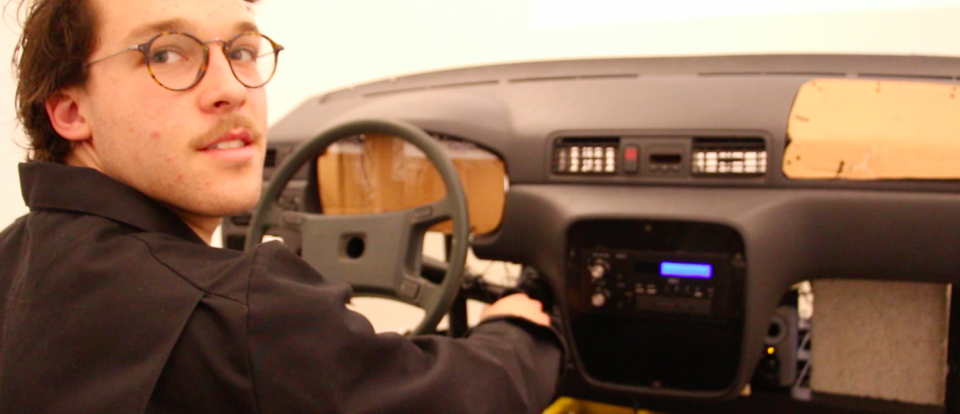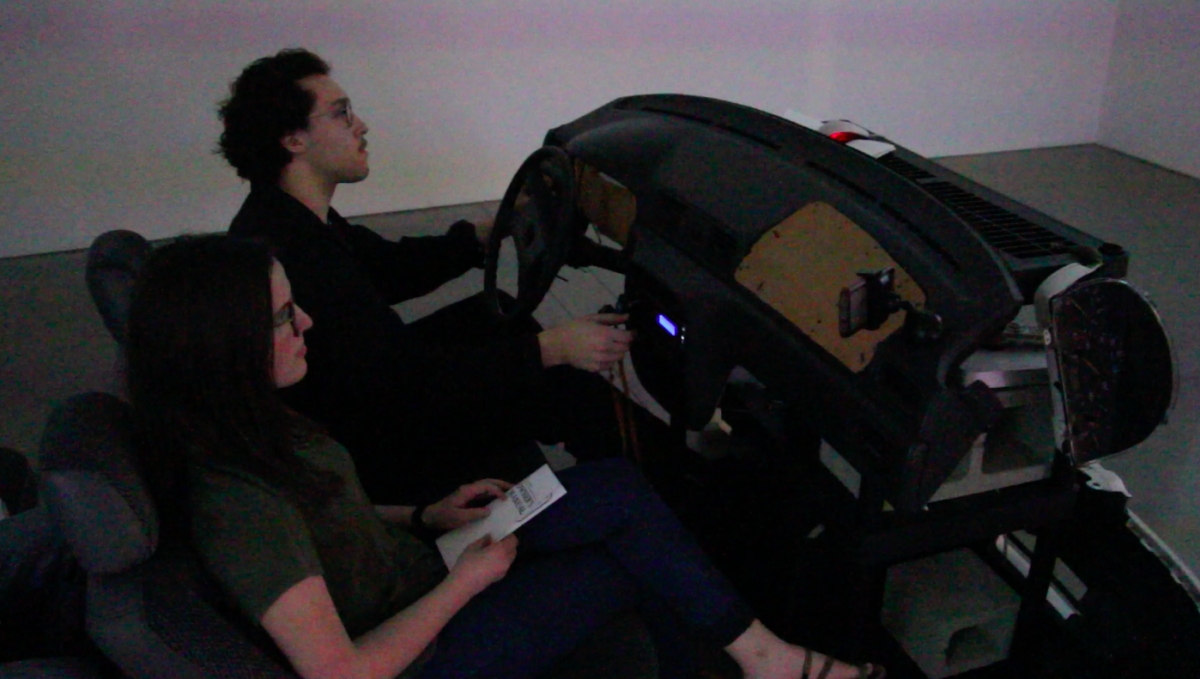
An interview with Miller Klitsner, creator of Bravo Drive
Posted on February 1st, 2017
by
Lee Tusman
Bravo Drive is an installation by Miller Klitsner currently on view in the exhibition Machinic Unconscious. We interviewed him about his installation.
GameLab: As I played Bravo Drive, I was struck by the slow unfolding of the world and of the way that the music was so tightly integrated. In fact the physical car radio buttons and knobs impact the visuals and play of Bravo Drive in a direct visceral way that I have not experienced in driving games before. For so many people, selecting a soundtrack for driving in a city sets the mood and creates a personal experience. What were some of the choices you made when deciding what controls would exist in Bravo Drive?
Klitsner: My original idea behind bravo drive developed from a combination of two separate ideas I had thought of previously. Originally, Bravo Drive had nothing to do with cars. It was going to be an interface placed at a podium (like that of a conductor) and the visuals were going to be a muted section of a film. The interface was only going to control the tempo, intensity, and mood of the music for the film. This would place the person interacting with the podium in a performative position. They would be doing a live scoring of the film.
GameLab: Bravo Drive emerged when I started to consider what the subject matter of the film would be. I remembered a documentary idea I had about observing the behavior of cars as anthropomorphized entities. That became a jumping off point for the visuals, and the controls themselves came naturally as I changed the installation from a podium to a dashboard to go with the subject of the film.
Klitsner: My intention with the controls was to create a metaphor between how we interact with music (specifically in relation to a narrative) and how we interact with cars. The controls of the car literally translate to controls of the cinematography and film’s score. While the radio mainly controls the audio, the mirror controls and steering wheel affect the cinematography. The gas and break as well as the radio’s tuner allow the performer to direct the pace and mood of both the music and the events going on on screen. These choices all revolved around the idea that as we drive in the real world, we curate the music around us and control the scene in front of us. My goal was to make an exaggeration of this notion and turn a car into the interface for a film director, the passengers becoming the audience. The driver is taking them on an audio-visual journey, and they define that journey in part by what scenes they choose to show, as well as by what music they choose to play to accompany the journey. The driver is making artistic decisions with the tools in front of them.
GameLab: When approaching the physical installation of Bravo Drive, one sees the guts of a car with seating and dash but missing the sleek, sexy exterior of a fiberglass frame. How does the physical installation of the car affect a player’s (driver’s?) experience of Bravo Drive?
Klitsner: Part of the subject matter of Bravo Drive is how we perceive cars and anthropomorphize them while dehumanizing the people within them. I wanted to invite people into the car. I wanted them to also feel the expansive space of being in a movie theatre. I also wanted to differentiate the device from the cars on-screen. The cars on-screen are meant be a visual representation of how we view other cars and their exteriors as the avatar or identity of the driver within them. As for the physical interface, I wanted it to feel like you were inside of a car that had been stripped down and repurposed for a new task. It has no wheels, and is not meant to take you anywhere physically. It is has been melded with a movie theatre, and instead it takes you on a filmic, musical journey.
GameLab: There are a number of articles written in the past year about games or experiences termed walking simulators, such as Proteus, which are often open exploratory worlds that convey a mood but may not have clear goals, enemies or win and lose states. Does Bravo Drive fit into this genre or lineage?
Klitsner: I never intended for it to come off as a walking simulator, although much of the definition of walking simulator applies. For some, Bravo Drive is more of an exploration game not just of the world on the screen but also the interface itself. However, the purpose of the experience is for one person to be the driver and perform the experience for their passive passenger audience.
GameLab: I think you chose to call Bravo Drive an interactive experience as opposed to a game. How does Bravo Drive respond to or work against a more typical driving game, even an openworld exploratory one with tightly integrated music, such as Grand Theft Auto?
Klitsner: As it is a work in progress, I can see how it has not quite been defined yet, but the idea is that you are not driving within the world on the screen. You are controlling the events and artistic elements on screen as a director might with a film, and so it is more of an interface for a performance.
GameLab: Is there a particular mood or space you are trying to conjure with Bravo Drive? Is there an aspect of meditation to your work?
Klitsner: I wanted to create a theatrical environment. The passengers are meant to feel like they are sitting in a dark movie theatre, where the driver is the director of the film. I wanted to meld this feeling with being on a road trip as well, which has similar associations. If you are driving at night, then it’s even more similar. Both in the movie theatre (or just watching a movie at home on the couch) and in the car, you are on a journey in a shared, possibly cozy space with other people. In this way, both road trips and watching film can be intimate shared experiences. I think part of this intimacy in this piece comes from the lack of verbal communication that also occurs in these shared experiences of driving and movie-watching, as well as the darkness of the room.
GameLab: I am now picturing myself driving on LA Freeways and I am wondering, is there an aspect of the sublime in Bravo Drive, or maybe a dystopia?
Klitsner: Yes to both! My original idea that turned into the content on screen was a documentary about cars. This documentary was to consist of footage of cars being observed in the way one might film herds of buffalo with grandiose music playing in the background. I was also imagining dystopic moments in the film in which we observe how we anthropomorphize cars (and thus dehumanize the actual people inside them) leading to unparalleled anger while driving. Seemingly perfectly decent people can become monsters when so many walls of identity are created when everyone’s faces are behind the darkened glaring windows of their vehicles….
Depending on what music you choose to turn the radio to, the mood and lighting changes, and you may find yourself looking at a car stuck sideways in a parking lot. It is up to you to interpret these audio-visual experiences, and it is also up to you to create them.
GameLab: What audio was selected or created for Bravo Drive?
Klitsner: I worked with my friend Cole Brossus to create them. We started with some loops of existing music and he augmented them to have more intensity as you pressed on the gas pedal
GameLab: Thank you.
Bravo Drive is part of the exhibition Machinic Unconscious at the New Wight Gallery, UCLA Broad Art Center through February 2.


